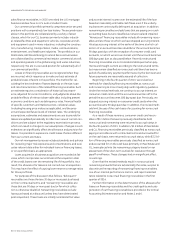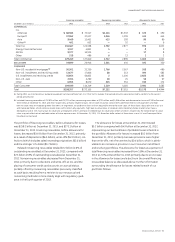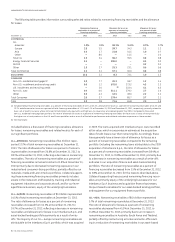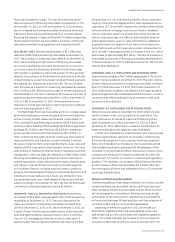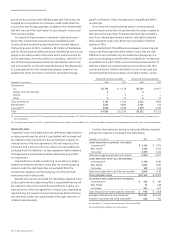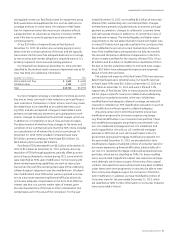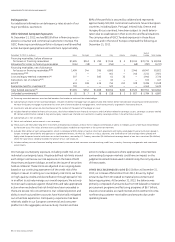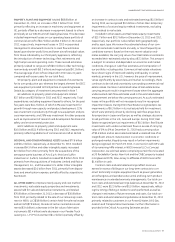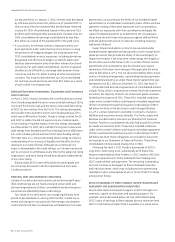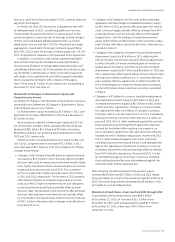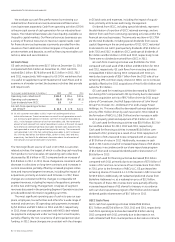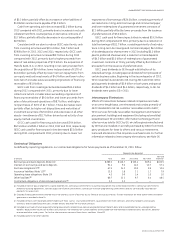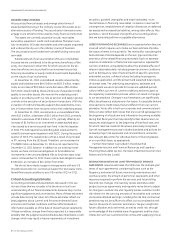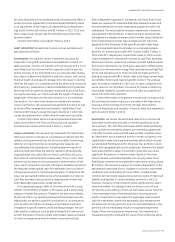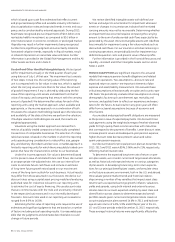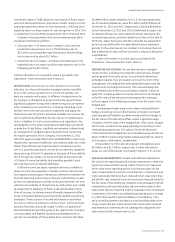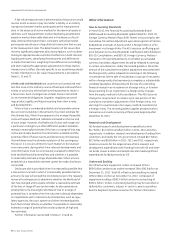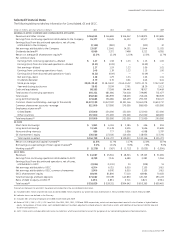GE 2013 Annual Report Download - page 62
Download and view the complete annual report
Please find page 62 of the 2013 GE annual report below. You can navigate through the pages in the report by either clicking on the pages listed below, or by using the keyword search tool below to find specific information within the annual report.’
60 GE 2013 ANNUAL REPORT
we assumed that, on January 1, 2014, interest rates decreased
by 100 basis points across the yield curve (a “parallel shift” in
that curve) and further assumed that the decrease remained
in place for 2014. We estimated, based on the year-end 2013
portfolio and holding all other assumptions constant, that our
2014 consolidated net earnings would decline by less than
$0.1 billion as a result of this parallel shift in the yield curve.
• It is our policy to minimize currency exposures and to con-
duct operations either within functional currencies or using
the protection of hedge strategies. We analyzed year-end
2013 consolidated currency exposures, including derivatives
designated and effective as hedges, to identify assets and
liabilities denominated in other than their relevant functional
currencies. For such assets and liabilities, we then evaluated
the effects of a 10% shift in exchange rates between those
currencies and the U.S. dollar, holding all other assumptions
constant. This analysis indicated that our 2014 consolidated
net earnings would decline by less than $0.1 billion as a result
of such a shift in exchange rates.
Debt and Derivative Instruments, Guarantees and Covenants
CREDIT RATINGS
On April 3, 2012, Moody’s Investors Service (Moody’s) announced
that it had downgraded the senior unsecured debt rating of GE by
one notch from Aa2 to Aa3 and the senior unsecured debt rating
of GECC by two notches from Aa2 to A1. The ratings downgrade
did not affect GE’s and GECC’s short-term funding ratings of P-1,
which were affi rmed by Moody’s. Moody’s ratings outlook for GE
and GECC is stable. We did not experience any material opera-
tional, funding or liquidity impacts from this ratings downgrade.
As of December 31, 2013, GE’s and GECC’s long-term unsecured
debt ratings from Standard and Poor’s Ratings Service (S&P) were
AA+ with a stable outlook and their short-term funding ratings
from S&P were A-1+. We are disclosing these ratings to enhance
understanding of our sources of liquidity and the effects of our
ratings on our costs of funds. Although we currently do not
expect a downgrade in the credit ratings, our ratings may be sub-
ject to a revision or withdrawal at any time by the assigning rating
organization, and each rating should be evaluated independently
of any other rating.
Substantially all GICs were affected by the downgrade and
are more fully discussed in the Principal Debt and Derivative
Conditions section.
PRINCIPAL DEBT AND DERIVATIVE CONDITIONS
Certain of our derivative instruments can be terminated if spec-
ifi ed credit ratings are not maintained and certain debt and
derivative agreements of other consolidated entities have provi-
sions that are affected by these credit ratings.
Fair values of our derivatives can change signifi cantly from
period to period based on, among other factors, market move-
ments and changes in our positions. We manage counterparty
credit risk (the risk that counterparties will default and not make
payments to us according to the terms of our standard master
agreements) on an individual counterparty basis. Where we have
agreed to netting of derivative exposures with a counterparty,
we offset our exposures with that counterparty and apply the
value of collateral posted to us to determine the net exposure.
We actively monitor these net exposures against defi ned limits
and take appropriate actions in response, including requiring
additional collateral.
Swap, forward and option contracts are executed under
standard master agreements that typically contain mutual down-
grade provisions that provide the ability of the counterparty to
require termination if the long-term credit ratings of the applica-
ble GE entity were to fall below A-/A3. In certain of these master
agreements, the counterparty also has the ability to require
termination if the short-term ratings of the applicable GE entity
were to fall below A-1/P-1. The net derivative liability after consid-
eration of netting arrangements, outstanding interest payments
and collateral posted by us under these master agreements was
estimated to be $1.2 billion at December 31, 2013. See Note 22.
Other debt and derivative agreements of consolidated entities
include Trinity, which comprises two entities that hold investment
securities, the majority of which are investment grade, and were
funded by the issuance of GICs. These GICs included conditions
under which certain holders could require immediate repayment
of their investment should the long-term credit ratings of GECC
fall below AA-/Aa3 or the short-term credit ratings fall below
A-1+/P-1, and are reported in investment contracts, insurance
liabilities and insurance annuity benefi ts. The Trinity assets and
liabilities are disclosed in note (a) in our Statement of Financial
Position. Another consolidated entity also had issued GICs where
proceeds are loaned to GECC. These GICs included conditions
under which certain holders could require immediate repayment
of their investment should the long-term credit ratings of GECC
fall below AA-/Aa3. These obligations are included in long-term
borrowings in our Statement of Financial Position. These three
consolidated entities ceased issuing GICs in 2010.
Following the April 3, 2012 Moody’s downgrade of GECC’s
long-term credit rating to A1, substantially all of these GICs
became redeemable by their holders. In 2012, holders of $2.4 bil-
lion in principal amount of GICs redeemed their holdings and
GECC made related cash payments. The remaining outstanding
GICs will continue to be subject to their scheduled maturities
and individual terms, which may include provisions permitting
redemption upon a downgrade of one or more of GECC’s ratings,
among other things.
RATIO OF EARNINGS TO FIXED CHARGES, INCOME MAINTENANCE
AGREEMENT AND SUBORDINATED DEBENTURES
GE provides implicit and explicit support to GECC through com-
mitments, capital contributions and operating support. For
example, and as discussed below, GE has committed to keep
GECC’s ratio of earnings to fi xed charges above a minimum level.
GECC’s credit rating is higher than it would be on a stand-alone


